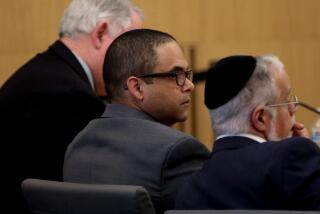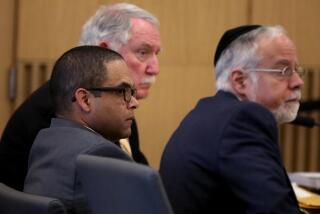A broken heart led LAPD officer to kill woman, prosecutor says
The letter read aloud in a downtown Los Angeles courtroom Monday was written more than 25 years ago by a young cop. If prosecutors are correct, they were the words of a heart-broken woman on the verge of committing murder in a jealous rage.
“I’m truly in love with John,” Stephanie Lazarus wrote to the mother of the man she had dated until he became engaged to another woman. “This year has torn me up.... I don’t think I’ll ever understand.”
Jurors heard the excerpt of the letter read by Deputy Dist. Atty. Shannon Presby in his opening statement as Lazarus’ murder trial got underway more than 2 1/2 years after her arrest.
Lazarus is accused of shooting and beating to death Sherri Rae Rasmussen, the wife of her ex-boyfriend, in 1986.
“A bite, a bullet, a gun barrel and a broken heart — that is the evidence that will prove that the defendant murdered Sherri Rae Rasmussen,” Presby told the jury, referring to DNA and ballistic evidence that he says proves Lazarus’ guilt.
Lazarus’ attorney, Mark Overland, followed Presby with a starkly different portrayal of his client and the evidence against her. Rejecting the notion that she was an obsessed, jilted lover, Overland said the former boyfriend, John Ruetten, doggedly pursued Lazarus even after becoming engaged to Rasmussen.
Fingerprints, hair and other evidence collected at the scene did not come from Lazarus and point to some other killer, he told the jury of eight women and four men.
Family members of the victim and the accused, curious onlookers and reporters packed into L.A. County Superior Court Judge Robert Perry’s courtroom to watch the attorneys’ opening gambits in a trial that has garnered national attention for its mix of CSI-like investigation, soap opera drama and the compelling idea that a respected LAPD detective may have had a successful career and family while carrying such a terrible, violent secret.
Ruetten returned home from work on Feb. 24, 1986, to find his wife’s body on the floor of their Van Nuys town house, according to police. She had been shot three times at close range in the chest, beaten badly and bitten on the arm.
Investigators gathered a saliva sample from the bite mark that ultimately led detectives to one of their own.
Lazarus, a 26-year veteran of the Los Angeles Police Department, was arrested in 2009 after the long-neglected case was reopened. Prosecutors say DNA testing that had not been available at the time of the killing showed the saliva from the bite belonged to Lazarus. She pleaded not guilty and has remained in custody throughout the long run-up to her trial in lieu of $10-million bail. Lazarus retired from the department in 2010.
The case will hinge largely on physical evidence collected at the crime scene. Overland has made clear that he will attempt to cast doubt on prosecutors’ assertion that the saliva and broken fingernails found at the crime scene contain Lazarus’ DNA and prove her guilt.
Overland has hammered on what he said is the prosecution’s inability to prove the evidence was stored and handled properly over the more than two decades between the slaying and Lazarus’ arrest. He told jurors that the sealed plastic tube that police say held the cotton swab with the saliva sample was found jutting through a hole in the evidence envelope in which it had been stored. He also said that hairs, a bloody palm print on the wall and fingerprints found at the crime scene did not come from Lazarus.
Rasmussen, a 29-year-old hospital nursing director, was killed a few months after her wedding. Overturned furniture and blood on the walls were evidence that a brutal struggle had occurred. Rasmussen’s head had been bludgeoned. Wounds on her wrist and cords on the floor indicated that she had been tied up.
A thick robe or blanket with bullet holes in it lay near her body. Police suspect the killer used it to muffle the sound of gunshots, and Presby told jurors the “unique” patterns of tearing on the fabric could have been created only by bullets that were issued to LAPD officers at the time. He added that the markings left by the bullets showed that a short-barreled .38-caliber gun was used in the killing. Weeks after Rasmussen was killed, Lazarus reported to Santa Monica police that someone had broken into her car and stolen the gun that matched that description.
Overland countered that gunshot analysis proved nothing conclusive, since any number of similar gun models could have been used and the bullets were not used exclusively by LAPD officers.
Lazarus was not considered a suspect at the time of the killing, despite repeated pleas by Rasmussen’s father to detectives that they look into the possibility. With Rasmussen’s BMW gone and electronic equipment stacked at the foot of the home’s stairs, the lead detective in the case theorized that two men had killed Rasmussen when she found them attempting to rob the home. That idea led nowhere and, eventually, the case was shelved and sat untouched for decades.
Lazarus joined the LAPD a few years before the killing, after she graduated from UCLA. At school she had become close with Ruetten, an engineering student, and the two dated off and on for a few years after finishing their studies.
Overland worked to knock down Presby’s portrayal of Lazarus as anguished over Ruetten’s decision to marry Rasmussen. Overland said it was Ruetten, not Lazarus, who refused to let the relationship go. Even after becoming engaged, Overland said Ruetten continued to pursue and have sex with Lazarus. Ruetten “is going to play a pivotal role in this case,” Overland said.
Teresa Lang, Rasmussen’s sister, testified after the opening statements that she had visited her sister the day before she was killed and that nothing seemed out of the ordinary.
As a cop, Lazarus worked varied assignments, was promoted to detective, and eventually landed a specialized post as one of the LAPD’s two art theft investigators. Along the way she married another LAPD officer, and the couple adopted a young daughter.
More to Read
Start your day right
Sign up for Essential California for news, features and recommendations from the L.A. Times and beyond in your inbox six days a week.
You may occasionally receive promotional content from the Los Angeles Times.







